Ultrasound of Small Bowel Obstruction: A Pictorial Review
Abstract
1. Introduction
- •
- Confirm or exclude intestinal obstruction (or lead to other differential diagnoses via detection);
- •
- Define the level of obstruction (stomach, jejunum, ileus, or colon);
- •
- Define the cause of the obstruction;
- •
- Define the severity of the obstruction (staging).
2. Ultrasound Technique
Tips and Tricks
3. Ultrasound Criteria for the Diagnosis of Small Bowel Occlusion
3.1. Diagnostic Criteria
3.1.1. Loop Dilatation
3.1.2. Kinesis Alteration
3.2. Staging Criteria
3.2.1. Free Fluid
3.2.2. Parietal Alterations
3.2.3. Ancillary Signs
4. Conclusions
Author Contributions
Funding
Institutional Review Board Statement
Informed Consent Statement
Data Availability Statement
Acknowledgments
Conflicts of Interest
References
- Catena, F.; De Simone, B.; Coccolini, F.; Di Saverio, S.; Sartelli, M.; Ansaloni, L. Bowel obstruction: A narrative review for all physicians. World J. Emerg. Surg. 2019, 14, 20. [Google Scholar] [CrossRef]
- Long, B.; Robertson, J.; Koyfman, A. Emergency Medicine Evaluation and Management of Small Bowel Obstruction: Evidence-Based Recommendations. J. Emerg. Med. 2018, 56, 166–176. [Google Scholar] [CrossRef]
- Hastings, R.S.; Powers, R.D. Abdominal pain in the, E.D. a 35 year retrospective. Am. J. Emerg. Med. 2011, 29, 711–716. [Google Scholar] [CrossRef] [PubMed]
- Cappell, M.S.; Batke, M. Mechanical obstruction of the small bowel and colon. Med. Clin. N. Am. 2008, 92, 575–597. [Google Scholar] [CrossRef]
- Miller, G.; Boman, J.; Shrier, I.; Gordon, P.H. Etiology of small bowel obstruction. Am. J. Surg. 2000, 180, 33–36. [Google Scholar] [CrossRef]
- Tamburrini, D.; Antinori, C.; Slotman, G. Recurrent Small Bowel Obstruction Caused by Metastatic Cervical Cancer with Negative PAP Screening. Am. Surg. 2018, 84, e305–e306. [Google Scholar] [CrossRef]
- Cesaro, E.; Rocco, C.; Rosano, N.; Ferrandino, G.; Marra, E.; Rispoli, C.; Maio, D.; Lugara, M.; Tamburrini, S.; Marano, I. “Bulb-like” sign: Small bowel closed loop obstruction in incarcerated Spigelian hernia. Radiol. Case Rep. 2021, 16, 520–523. [Google Scholar] [CrossRef] [PubMed]
- Skoglar, A.; Gunnarsson, U.; Falk, P. Band adhesions not related to previous abdominal surgery—A retrospective cohort analysis of risk factors. Ann. Med. Surg. 2018, 36, 185–190. [Google Scholar] [CrossRef] [PubMed]
- Sarani, B.; Paspulati, R.M.; Hambley, J.; Efron, D.; Martinez, J.; Perez, A.; Bowles-Cintron, R.; Yi, F.; Hill, S.; Meyer, D.; et al. A multidisciplinary approach to diagnosis and management of bowel obstruction. Curr. Probl. Surg. 2018, 55, 394–438. [Google Scholar] [CrossRef]
- Menconi, G.; Schembari, E.; Randazzo, V.; Mattone, E.; Coco, O.; Mannino, M.; Di Carlo, I.; Toro, A. Intestinal obstruction due to congenital bands in adults who have never had abdominal surgery Two case reports and a review of the literature. Ann. Ital. Chir. 2019, 90, 524–531. [Google Scholar]
- Tamburrini, S.; Lugara, M.; Iaselli, F.; Saturnino, P.P.; Liguori, C.; Carbone, R.; Vecchione, D.; Abete, R.; Tammaro, P.; Marano, I. Diagnostic Accuracy of Ultrasound in the Diagnosis of Small Bowel Obstruction. Diagnostics 2019, 9, 88. [Google Scholar] [CrossRef]
- Tamburrini, S.; Serra, N.; Lugara, M.; Mercogliano, G.; Liguori, C.; Toro, G.; Somma, F.; Mandato, Y.; Guerra, M.V.; Sarti, G.; et al. Ultrasound Signs in the Diagnosis and Staging of Small Bowel Obstruction. Diagnostics 2020, 10, 277. [Google Scholar] [CrossRef]
- Dombert, L.; Hussain, A.; Bullock, B.; Liu, X.; Faughnan, P.; Pigneri, D.; May, A.; Mathews, T.; Semenza, K.; Granet, J.; et al. Impact of Protocol Utilizing Water-Soluble Contrast for Adhesive Small Bowel Obstruction. J. Surg. Res. 2020, 259, 487–492. [Google Scholar] [CrossRef]
- Katano, T.; Shimura, T.; Nishie, H.; Iwai, T.; Itoh, K.; Ebi, M.; Mizuno, Y.; Togawa, S.; Shibata, S.; Yamada, T.; et al. The first management using intubation of a nasogastric tube with Gastrografin enterography or long tube for non-strangulated acute small bowel obstruction: A multicenter, randomized controlled trial. J. Gastroenterol. 2020, 55, 858–867. [Google Scholar] [CrossRef]
- Ceresoli, M.; Coccolini, F.; Catena, F.; Montori, G.; Di Saverio, S.; Sartelli, M.; Ansaloni, L. Water-soluble contrast agent in adhesive small bowel obstruction: A systematic review and meta-analysis of diagnostic and therapeutic value. Am. J. Surg. 2016, 211, 1114–1125. [Google Scholar] [CrossRef] [PubMed]
- Tong, J.W.V.; Lingam, P.; Shelat, V.G. Adhesive small bowel obstruction—an update. Acute Med. Surg. 2020, 7, e587. [Google Scholar] [CrossRef]
- Catena, F.; Di Saverio, S.; Coccolini, F.; Ansaloni, L.; De Simone, B.; Sartelli, M.; Van Goor, H. Adhesive small bowel adhesions obstruction: Evolutions in diagnosis, management and prevention. World J. Gastrointest. Surg. 2016, 8, 222–231. [Google Scholar] [CrossRef] [PubMed]
- Catena, F.; Di Saverio, S.; Kelly, M.D.; Biffl, W.L.; Ansaloni, L.; Mandala, V.; Velmahos, G.C.; Sartelli, M.; Tugnoli, G.; Lupo, M.; et al. Bologna Guidelines for Diagnosis and Management of Adhesive Small Bowel Obstruction (ASBO): 2010 Evidence-Based Guidelines of the World Society of Emergency Surgery. World J. Emerg. Surg. 2011, 6, 5. [Google Scholar] [CrossRef]
- Diamond, M.; Lee, J.; LeBedis, C.A. Small Bowel Obstruction and Ischemia. Radiol. Clin. N. Am. 2019, 57, 689–703. [Google Scholar] [CrossRef] [PubMed]
- Kim, J.; Lee, Y.; Yoon, J.H.; Lee, H.J.; Lim, Y.J.; Yi, J.; Jung, W.B. Non-strangulated adhesive small bowel obstruction: CT findings predicting outcome of conservative treatment. Eur. Radiol. 2020, 31, 1597–1607. [Google Scholar] [CrossRef]
- Scaglione, M.; Galluzzo, M.; Santucci, D.; Trinci, M.; Messina, L.; Laccetti, E.; Faiella, E.; Beomonte Zobel, B. Small bowel obstruction and intestinal ischemia: Emphasizing the role of MDCT in the management decision process. Abdom. Radiol. 2020. [Google Scholar] [CrossRef]
- Liu, W.; Shi, M.Q.; Ge, Y.S.; Wang, P.Y.; Wang, X. Multisection spiral CT in the diagnosis of adhesive small bowel obstruction: The value of CT signs in strangulation. Clin. Radiol. 2021, 76, 75.e5–75.e11. [Google Scholar] [CrossRef]
- Ferris, B.; Bastian-Jordan, M.; Fenwick, J.; Hislop-Jambrich, J. Vascular assessment in small bowel obstruction: Can CT predict requirement for surgical intervention? Abdom. Radiol. 2020. [Google Scholar] [CrossRef]
- Zins, M.; Millet, I.; Taourel, P. Adhesive Small Bowel Obstruction: Predictive Radiology to Improve Patient Management. Radiology 2020, 296, 480–492. [Google Scholar] [CrossRef]
- Maglinte, D.D.; Howard, T.J.; Lillemoe, K.D.; Sandrasegaran, K.; Rex, D.K. Small-bowel obstruction: State-of-the-art imaging and its role in clinical management. Clin. Gastroenterol. Hepatol. 2008, 6, 130–139. [Google Scholar] [CrossRef] [PubMed]
- Silva, A.C.; Pimenta, M.; Guimaraes, L.S. Small bowel obstruction: What to look for. Radiographics 2009, 29, 423–439. [Google Scholar] [CrossRef]
- McKenna, D.A.; Roche, C.J.; Murphy, J.M.; McCarthy, P.A. Polyethylene glycol solution as an oral contrast agent for MRI of the small bowel in a patient population. Clin. Radiol. 2006, 61, 966–970. [Google Scholar] [CrossRef] [PubMed]
- Inoue, A.; Furukawa, A.; Takaki, K.; Imai, Y.; Ota, S.; Nitta, N.; Watanabe, Y. Noncontrast MRI of acute abdominal pain caused by gastrointestinal lesions: Indications, protocol, and image interpretation. Jpn. J. Radiol. 2020, 39, 209–224. [Google Scholar] [CrossRef] [PubMed]
- Hollerweger, A.; Wustner, M.; Dirks, K. Bowel Obstruction: Sonographic Evaluation. Ultraschall. Med. 2015, 36, 216–235; quiz 236–218. [Google Scholar] [CrossRef]
- Borisenko, V.B.; Kovalev, A.N.; Denysiuk, T.A. Role and place of ultrasonography in diagnostics of adhesive intestinal obstruction. Wiad. Lek. 2020, 73, 83–86. [Google Scholar] [CrossRef]
- Pourmand, A.; Dimbil, U.; Drake, A.; Shokoohi, H. The Accuracy of Point-of-Care Ultrasound in Detecting Small Bowel Obstruction in Emergency Department. Emerg. Med. Int. 2018, 2018, 3684081. [Google Scholar] [CrossRef]
- Jang, T.B.; Schindler, D.; Kaji, A.H. Bedside ultrasonography for the detection of small bowel obstruction in the emergency department. Emerg. Med. J. 2011, 28, 676–678. [Google Scholar] [CrossRef]
- Boniface, K.S.; King, J.B.; LeSaux, M.A.; Haciski, S.C.; Shokoohi, H. Diagnostic Accuracy and Time-Saving Effects of Point-of-Care Ultrasonography in Patients with Small Bowel Obstruction: A Prospective Study. Ann. Emerg. Med. 2019, 75, 246–256. [Google Scholar] [CrossRef] [PubMed]
- Atkinson, N.S.S.; Bryant, R.V.; Dong, Y.; Maaser, C.; Kucharzik, T.; Maconi, G.; Asthana, A.K.; Blaivas, M.; Goudie, A.; Gilja, O.H.; et al. How to perform gastrointestinal ultrasound: Anatomy and normal findings. World J. Gastroenterol. 2017, 23, 6931–6941. [Google Scholar] [CrossRef] [PubMed]
- Maconi, G.; Nylund, K.; Ripolles, T.; Calabrese, E.; Dirks, K.; Dietrich, C.F.; Hollerweger, A.; Sporea, I.; Saftoiu, A.; Maaser, C.; et al. EFSUMB Recommendations and Clinical Guidelines for Intestinal Ultrasound (GIUS) in Inflammatory Bowel Diseases. Ultraschall Med. 2018, 39, 304–317. [Google Scholar] [CrossRef]
- Fleischer, A.C.; Dowling, A.D.; Weinstein, M.L.; James, A.E., Jr. Sonographic patterns of distended, fluid-filled bowel. Radiology 1979, 133 Pt 1, 681–685. [Google Scholar] [CrossRef]
- Shokoohi, H.; Boniface, K.S.; Loesche, M.A.; Duggan, N.M.; King, J.B. Development of a nomogram to predict small bowel obstruction using point-of-care ultrasound in the emergency department. Am. J. Emerg. Med. 2020, 38, 2356–2360. [Google Scholar] [CrossRef] [PubMed]
- Gottlieb, M.; Peksa, G.D.; Pandurangadu, A.V.; Nakitende, D.; Takhar, S.; Seethala, R.R. Utilization of ultrasound for the evaluation of small bowel obstruction: A systematic review and meta-analysis. Am. J. Emerg. Med. 2018, 36, 234–242. [Google Scholar] [CrossRef]
- Di Mizio, R.; Grassi, R.; Marchese, E.; Basti, M.; Di Campli, G.; Catalano, O.; Rotondo, A.; Fanucci, A. [“Uncompensated” small bowel obstruction in adults. Ultrasonographic findings of free fluid between loops and its prognostic value]. Radiol. Med. 1995, 89, 787–791. [Google Scholar]
- Grassi, R.; Romano, S.; D’Amario, F.; Giorgio Rossi, A.; Romano, L.; Pinto, F.; Di Mizio, R. The relevance of free fluid between intestinal loops detected by sonography in the clinical assessment of small bowel obstruction in adults. Eur J. Radiol. 2004, 50, 5–14. [Google Scholar] [CrossRef]
- Iacobellis, F.; Berritto, D.; Belfiore, M.P.; Di Lanno, I.; Maiorino, M.; Saba, L.; Grassi, R. Meaning of free intraperitoneal fluid in small-bowel obstruction: Preliminary results using high-frequency microsonography in a rat model. J. Ultrasound Med. 2014, 33, 887–893. [Google Scholar] [CrossRef] [PubMed]
- Tamburrini, S.; Setola, F.R.; Belfiore, M.P.; Saturnino, P.P.; Della Casa, M.G.; Sarti, G.; Abete, R.; Marano, I. Ultrasound diagnosis of typhlitis. J. Ultrasound 2019, 22, 103–106. [Google Scholar] [CrossRef] [PubMed]
- Reginelli, A.; Genovese, E.; Cappabianca, S.; Iacobellis, F.; Berritto, D.; Fonio, P.; Coppolino, F.; Grassi, R. Intestinal Ischemia: US-CT findings correlations. Crit. Ultrasound J. 2013, 5 (Supp. S1), S7. [Google Scholar] [CrossRef]
- Kanzaki, T.; Hata, J.; Imamura, H.; Manabe, N.; Okei, K.; Kusunoki, H.; Kamada, T.; Shiotani, A.; Haruma, K. Contrast-enhanced ultrasonography with Sonazoid for the evaluation of bowel ischemia. J. Med. Ultrason. 2012, 39, 161–167. [Google Scholar] [CrossRef] [PubMed]
- Hata, J.; Kamada, T.; Haruma, K.; Kusunoki, H. Evaluation of bowel ischemia with contrast-enhanced, U.S. initial experience. Radiology 2005, 236, 712–715. [Google Scholar] [CrossRef]
- Frasure, S.E.; Hildreth, A.F.; Seethala, R.; Kimberly, H.H. Accuracy of abdominal ultrasound for the diagnosis of small bowel obstruction in the emergency department. World J. Emerg. Med. 2018, 9, 267–271. [Google Scholar] [CrossRef]
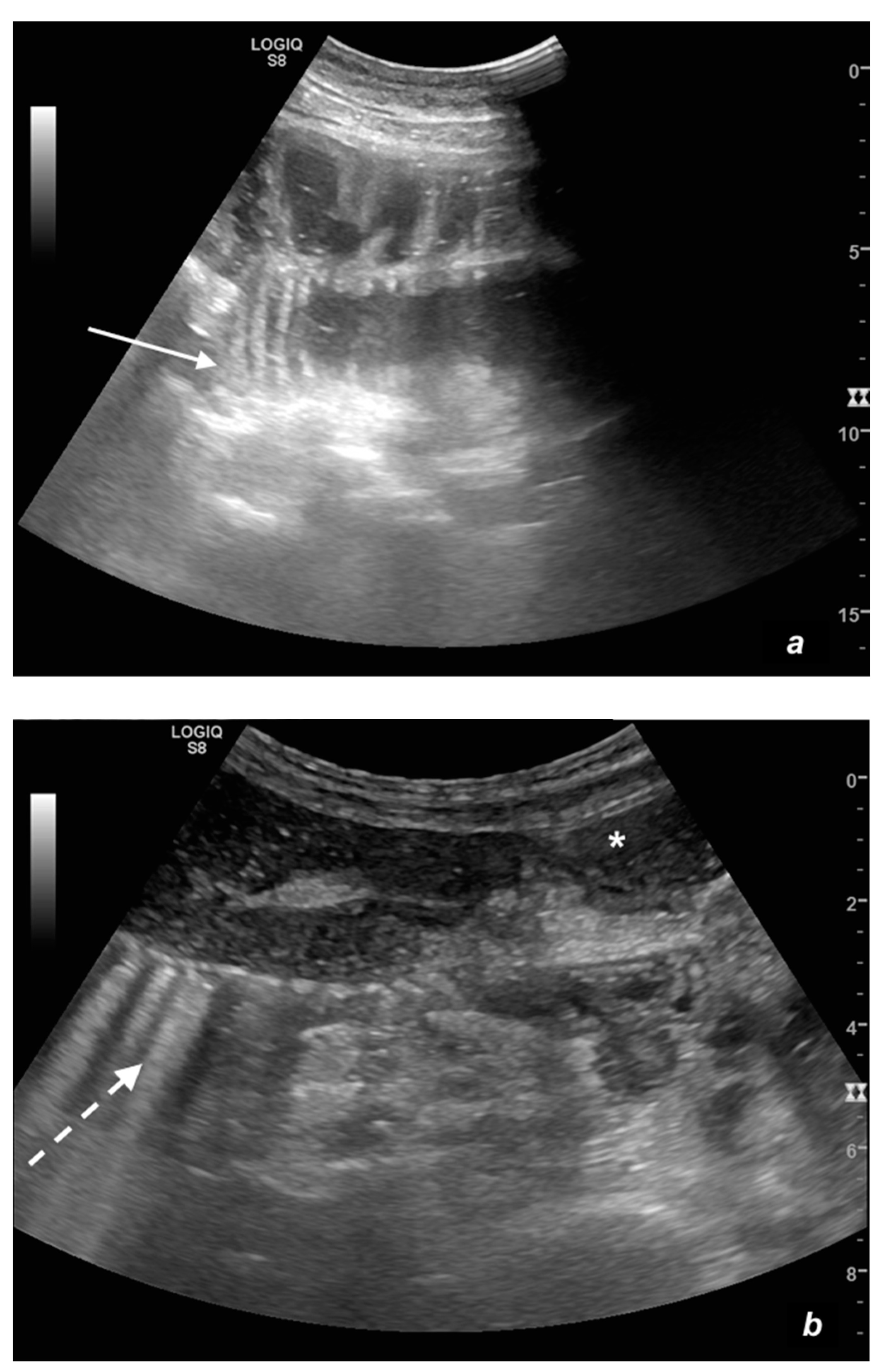
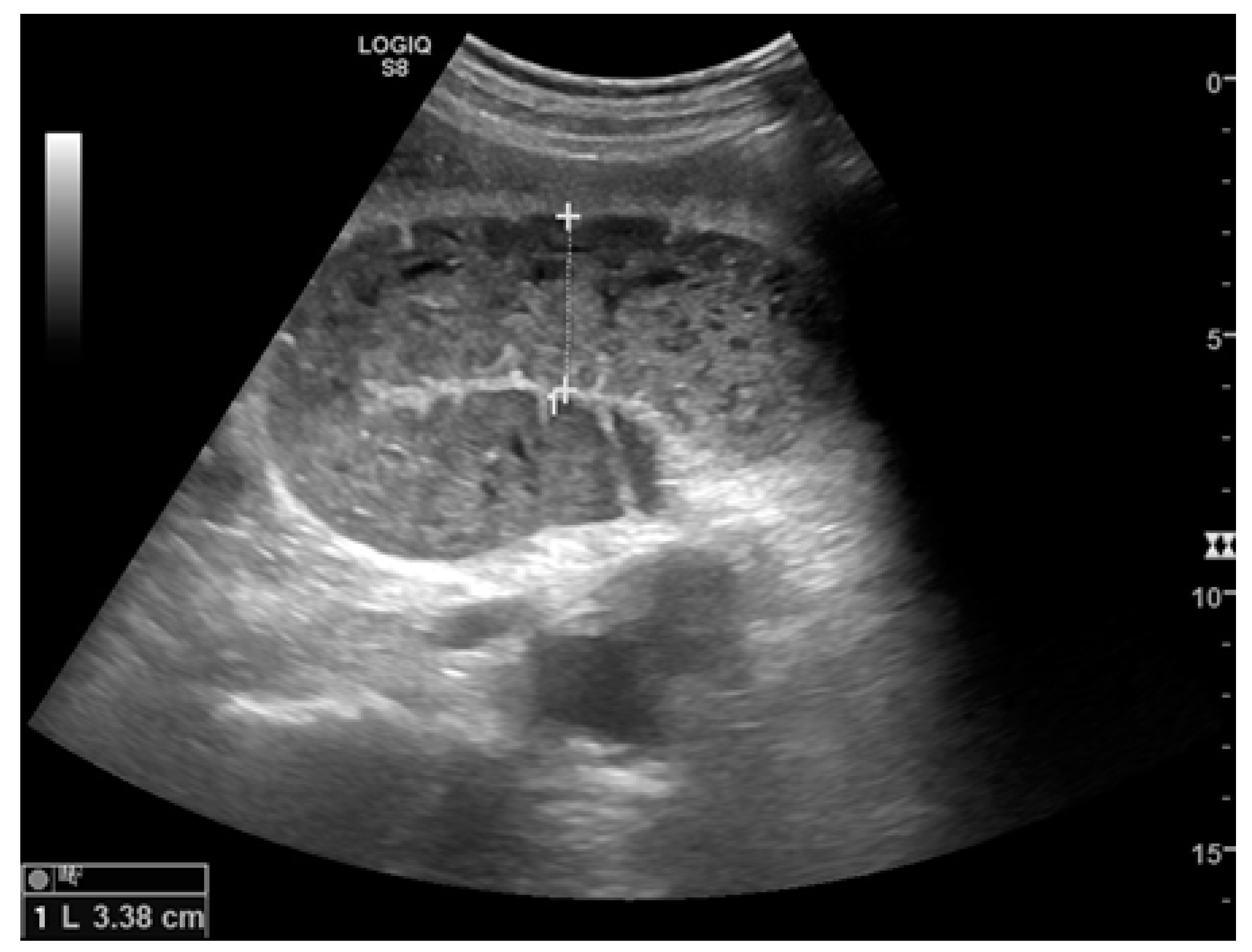
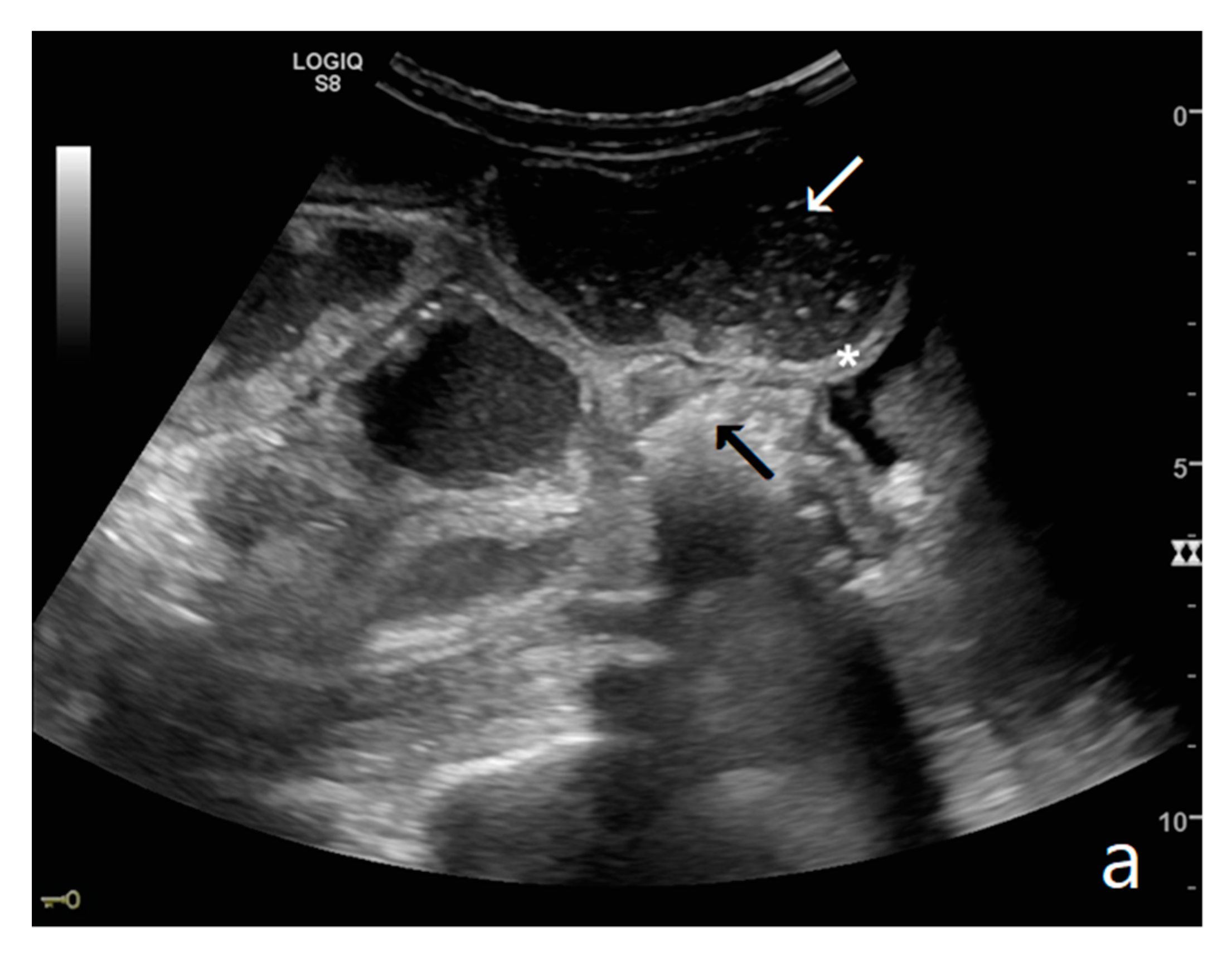

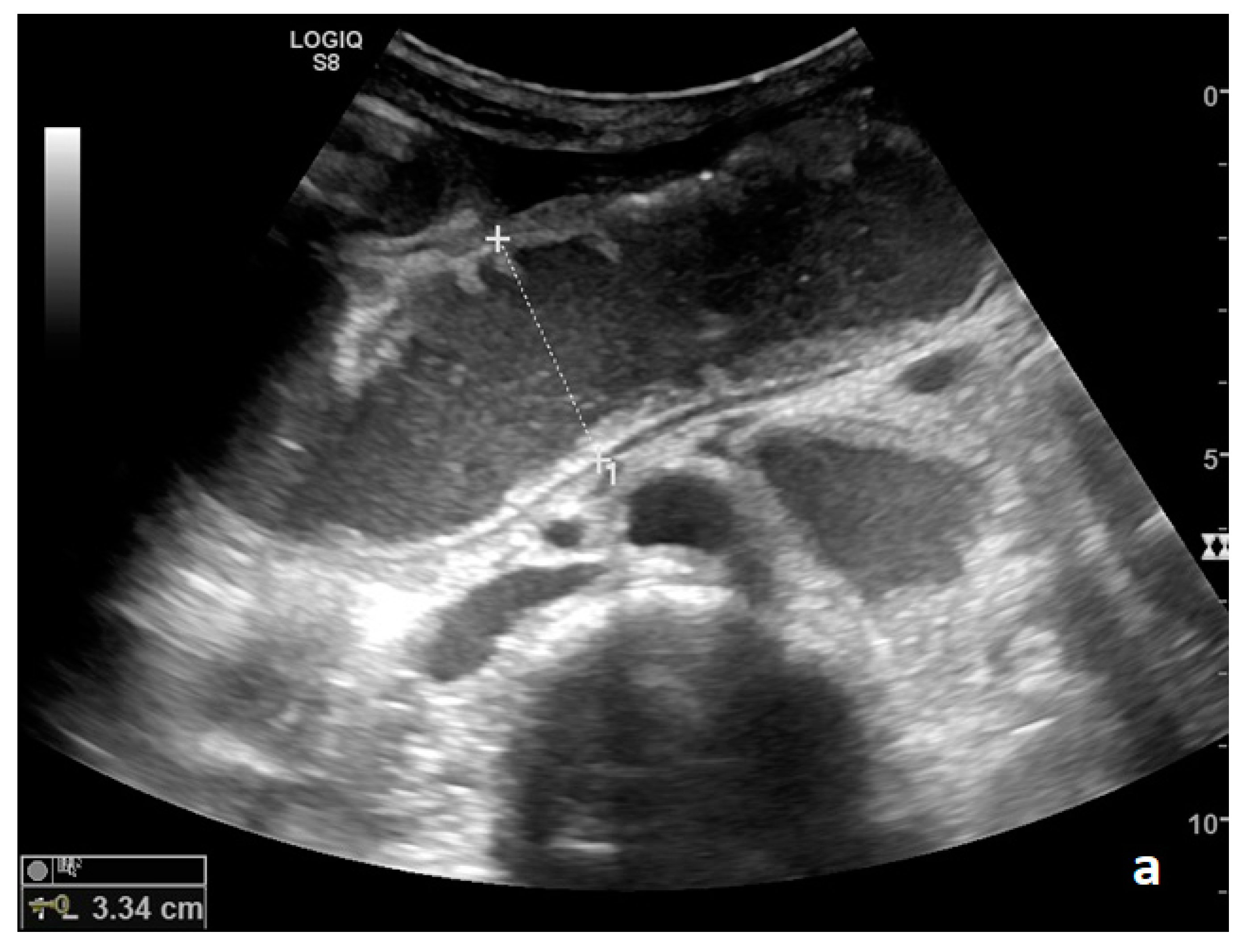
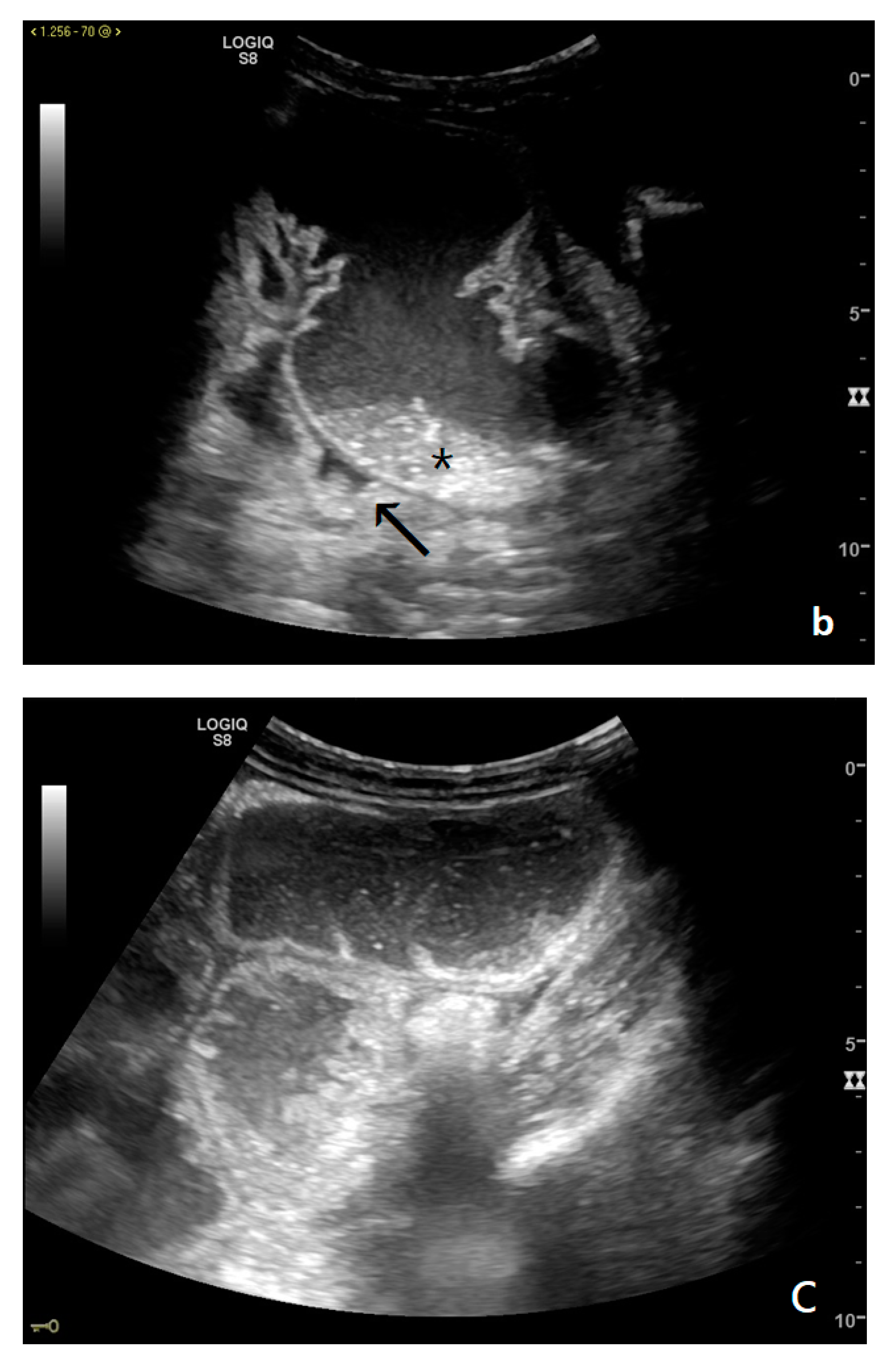



| Simple | Decompensated | Complicated | |
|---|---|---|---|
| Bowel Loop Diameter | Increased | Increased | Increased |
| Parietal Thickness | Normal | Normal or Increased | Increased |
| Valvulae Conniventes | Not Thickened | Not Thickened | Thickened |
| Peristalsis | Present and/or Hyperkinetic | Decreased | Absent |
| Free Fluid | Absent | Present | Present |
| Diagnostic Criteria | |
|---|---|
| Loop Dilation | >2.5 cm |
| Kinesis Alterations | Altered Hyperkinesis (Early SBO) Hypokinesis Akinesis |
| Staging Criteria | |
| Free Fluid | |
| Parietal Alterations | Parietal and Valvulae Conniventes Thickening Parietal Wall Stratification |
| Ancillary Signs (Increased Diagnostic Confidence) | ‘Caliber Jump’ ‘Kinesis Jump’ |
Publisher’s Note: MDPI stays neutral with regard to jurisdictional claims in published maps and institutional affiliations. |
© 2021 by the authors. Licensee MDPI, Basel, Switzerland. This article is an open access article distributed under the terms and conditions of the Creative Commons Attribution (CC BY) license (https://creativecommons.org/licenses/by/4.0/).
Share and Cite
Rosano, N.; Gallo, L.; Mercogliano, G.; Quassone, P.; Picascia, O.; Catalano, M.; Pesce, A.; Fiorini, V.; Pelella, I.; Vespere, G.; et al. Ultrasound of Small Bowel Obstruction: A Pictorial Review. Diagnostics 2021, 11, 617. https://doi.org/10.3390/diagnostics11040617
Rosano N, Gallo L, Mercogliano G, Quassone P, Picascia O, Catalano M, Pesce A, Fiorini V, Pelella I, Vespere G, et al. Ultrasound of Small Bowel Obstruction: A Pictorial Review. Diagnostics. 2021; 11(4):617. https://doi.org/10.3390/diagnostics11040617
Chicago/Turabian StyleRosano, Nicola, Luigi Gallo, Giuseppe Mercogliano, Pasquale Quassone, Ornella Picascia, Marco Catalano, Antonella Pesce, Valeria Fiorini, Ida Pelella, Giuliana Vespere, and et al. 2021. "Ultrasound of Small Bowel Obstruction: A Pictorial Review" Diagnostics 11, no. 4: 617. https://doi.org/10.3390/diagnostics11040617
APA StyleRosano, N., Gallo, L., Mercogliano, G., Quassone, P., Picascia, O., Catalano, M., Pesce, A., Fiorini, V., Pelella, I., Vespere, G., Romano, M., Tammaro, P., Marra, E., Oliva, G., Lugarà, M., Scuderi, M., Tamburrini, S., & Marano, I. (2021). Ultrasound of Small Bowel Obstruction: A Pictorial Review. Diagnostics, 11(4), 617. https://doi.org/10.3390/diagnostics11040617







